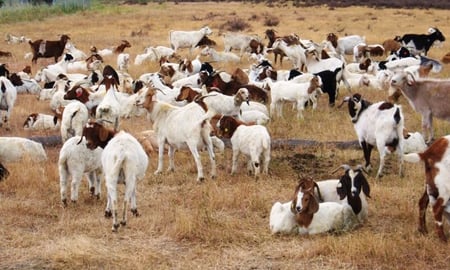 Fonti energetiche alternative
Fonti energetiche alternative  Commenti disabilitati su Google e le sue 200 CAPRE!!
Commenti disabilitati su Google e le sue 200 CAPRE!! Google e le sue 200 CAPRE!!
 Il celeberrimo motore di ricerca partecipa alla riduzione delle emissioni:
Il celeberrimo motore di ricerca partecipa alla riduzione delle emissioni:
Per la manutenzione dei prati, STOP ai tagliaerba e via ad uno stuolo di CAPRE!!
Google, forse anche grazie alla attuale crisi (della quale vedremo ancora DRAMMATICHE EVOLUZIONI) ha varato un sostanzioso piano di tagli ai costi. In questo pacchetto, le spese per la manutenzione dei prati della Silicon Valley.
lA COSA PIU’ GENUINA, OVVIA E ANTICA DELLA TERRA!!
Google hires goat army for lawn maintenance
Bleats mowing the lawn
By Austin Modine
Job openings are few and slim in Silicon Valley these days, but at least Google is hiring. Applicants are required to have at least 2 years experience eating grass with a four-chambered stomach.
Google said today it has enlisted a small army of hungry, hungry goats to help manicure the expansive fields at its Mountain View headquarters.

Image courtesy the Google Blog
The internet’s top ad broker wrote in its official blog that the goats are hired from a local goat rental business to clear weeds and brush to reduce fire hazard.
A herder brings about 200 goats and they spend roughly a week with us at Google, eating the grass and fertilizing at the same time. The goats are herded with the help of Jen, a border collie. It costs us about the same as mowing, and goats are a lot cuter to watch than lawn mowers.
Yes, it’s all eco-friendly fun and games until Googlers start spreading Goat Flu to the masses. ®
E quindi ecco la California Grazing:
 Go Green. Go Goats.
Go Green. Go Goats.
California Grazing provides holistic land management and brush & weed control through grazing. We can eliminate noxious weeds, restore native grasses, and address fire prevention through fuel load reduction.
Our fleet of 800+ environmentally friendly, self propelled weed eaters are ready for your project! These cute & cost effective critters remove thistle, brush, weeds, and other invasive plants.
Benefits
Goat grazing is a cost effective, ecologically sound way to clear land and promote growth of native grasses and beneficial plants, particularly for large acreages and difficult terrain. It has been proven to efficiently handle areas that are inaccessible or difficult to manage with mowers, areas where burns are inadvisable, and sensitive areas where the application of herbicides is not appropriate.
Our goats restore plant species that better clean the air, reduce water pollution, prevent the spread of fires, eliminate mower emissions, and fertilize while they graze!
Star Thistle
Yellow star thistle is named for its bright thistle-like flowers, which have sharp spines surrounding their base. It is a long-lived annual and is found at elevations of 7000 feet or less. It grows anywhere from 6 inches to 5 feet tall. Most of the plant’s seeds germinate within a year of disbursement, yet some can stay viable for up to 3 years.
Goat grazing is a highly effective way of reducing star thistle and star thistle seed production. Goats will eat the plants in all stages, including after the spines form. Quite surprisingly, goats like thistle – it is one of the first plants they will eat when present. Intensive grazing managed over time by goats provides positive and successful results in the eradication of star thistle.
Aggressive noxious weeds like thistle bring problems as they displace beneficial plants, and reduce habitat and recreational value. Goat grazing is also an effective method for control of other weed species such as Spurge, Nettles, Purple Star thistle, Artichoke thistle, Poison Ivy and Poison Oak. Whereas human contact with Poison Oak or Poison Ivy can cause an allergic reaction in humans, goats relish them and are highly effective at eradicating this weed.
Other plants goats like to eat include: Vetch, Yellow and Purple Star Thistle, Bull Thistle, French Broom, Mustard, Himalayan Blackberry, Coyote Bush, Ivy, Pine and Oak Saplings, Poison Oak, Eucalyptus Saplings, Poison Hemlock, Sage, Ivy, and most grasses.
Riparian Restoration
A riparian area is one that is located on the bank of a natural waterway, such as a river or lake. By carefully managing grazing in riparian areas, healthy plants will build strong stream banks. Permanent vegetative cover provides the most effective way to reduce soil erosion. Raindrops, for example, lose some of their force when they land on plants. They run off the vegetation down to the ground rather than pounding the soil at their full velocity. More water soaks into the ground instead of running off, which helps to eliminate soil erosion.
Root systems of beneficial plants hold soil in place and filter contaminants. These root systems allow water to flow more clearly as impurities are filtered out before reaching ground water. Grazing management also minimizes vegetation growth and blockage of natural waterways. Grazing with goats encourages a healthy watershed and reduces pollution in our lakes, rivers and streams – and we all benefit from clean water!
Mountain, valley, desert or coast, we must preserve the wonder that is California!
Fuel Reduction
Goats eat “hot fuel,” the spindly plants that grow under trees and allow fire to spread quickly. Unlike other animals, goats are naturally adapted to eating weeds, brush, thistles and invasive plants. They have evolved their own razing mechanisms for digesting and processing even the most noxious of weeds. Fuel load reduction with goats is accomplished by the use of a temporary electric fence. This standard farm fencing enables us to control the goats’ grazing pattern.